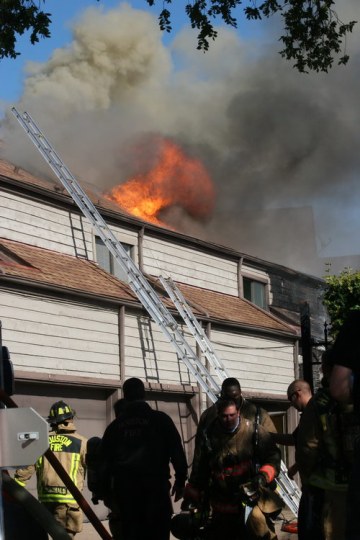
As we have pointed out so many times on this site in the past, some buildings are just going to be a challenge. Captain Adam Kibler from Houston Engine 28 sent in these pictures of one of those challenging jobs. The fire building was a wood frame two story condominium with multiple roof lines. The multiple roof lines presented the crews with a challenge since they created a situation with multiple attics and multiple ceiling levels inside. In this case, the fire started in the first floor garage and quick spread through the walls into the different attics and various void spaces. The living room had 15+ foot tall ceilings which allowed for clear cool conditions inside despite the advancing fire. These tall ceiling also required the use of attic ladders and long pike poles on the inside. Ladder 51 made the roof and cut various vent holes shown below.
An aggressive interior attack, paired with the required roof vent allowed the Houston crews to keep this fire contained to the end units of the building. If it wasn’t for the vent (and the aggressive attack) the outcome would have be totally different. Remember, vent early, vent often!
Click Here to see some more photos of the fire.

Even though I don’t like to comment on photos of buildings that aren’t in my city…..
Hard (and speedy) work I’m sure but the results speak for themselves.
DAMN YOU, FitSsikS! That’s what I was gonna do!!! 🙂 That’s funny as hell!
Speaking of Ladder 51, has it received a clean bill of health yet or……?
granted this was probably a hard job but it looks like these boys did some fine vent work.
Great job guys, impressive work keeping the fire contained to the end unit. Thanks for sending this in. Whats the staffing like in Huston? How many to an engine/ladder and how many of each are you getting for a structure assignment?
-Ladder 51 – as far as I know it is out of service at the shop. Rumor is it is totally scrapped! Think about it- every switch, light, fuse, wiring harness, etc had who knows how many volts through it. If you think about it every peice of steel should be welded together.
We are just happy everyone is ok!
-Staffing
Engine – 1 Captain, 1 engineer operator, 2 firefighters
Ladder – 1 Senior Captain, 1 EO, 2 firefighters
District Chief- 1 District Chief, 1 ICT-Incident Comand Technician EO rank
Dispatch goes as follows- ( I think)
-House fire- 3 engs, 1 ladder, 1 chief, 1 amb
1-11 (working fire) gets and extra eng, ladder and chief
-Apartment, wharehouse or large building- 4 engs, 2 ladders, 2 chiefs 1 amb, safety officer (sr captain rank)
-high rise- 6 engs, 4 ladders, 4 chiefs, 1 amb, 1 safety,
2-11- depending on the intial dispach is the same as the first PLUS a rescue, chief, paramedic squad, ems super, rehab truck, cascade truck, deputy chief
3-11 and above gets the same plus a command van
……I think……. I just go where they dispatch me…
More info can be found here.
We used to have awesome station websites but downtown came down with an order ending all photos, video and media….maybe it will come back someday
http://www.houstontx.gov/fire/
Run stats can be found here
http://www.houstontx.gov/fire/abouthfd/statistics.html
Some random fire pics can found here
http://www.tac-7.com
Kibler28:
Thanks for the info and yes indeed, the important thing is that all of the ffs are ok.
When I got hired as an ff there was a guy who’s nickname was Captain Kilowatt.
Wanna guess what he did? 😉
Excellent job, Houston Fire. Great vent work. Love the staffing of your rigs!!
Hey with this post I thought it would be good to talk about different roof venting techniques used.
I know in my area of Western New York there are many different ways to cut holes.
The Rochester FD uses what they call the Peak Cut, which is 4 cuts parrelel with the rafters and then a diagonal cut across all 4 veritical cuts. A couple swings with the axe and the hole falls in.
I have also heard of the Syracuse Cut witch all the cutting is done from the roof ladder. It is 4 Horizantal cuts Starting from the peak and about 2 feet a part working down. and then 1 verticle cut along the side of the roof ladder, this should give you a rough 2X8 hole.
I know in Monroe county (Greater Rochester NY) we use a belt invented by a LT in the RFD called the Wydra Belt which enables us to step off the roof ladder on a peaked roof and still be secured.
Good Article
Ali Jahanfard